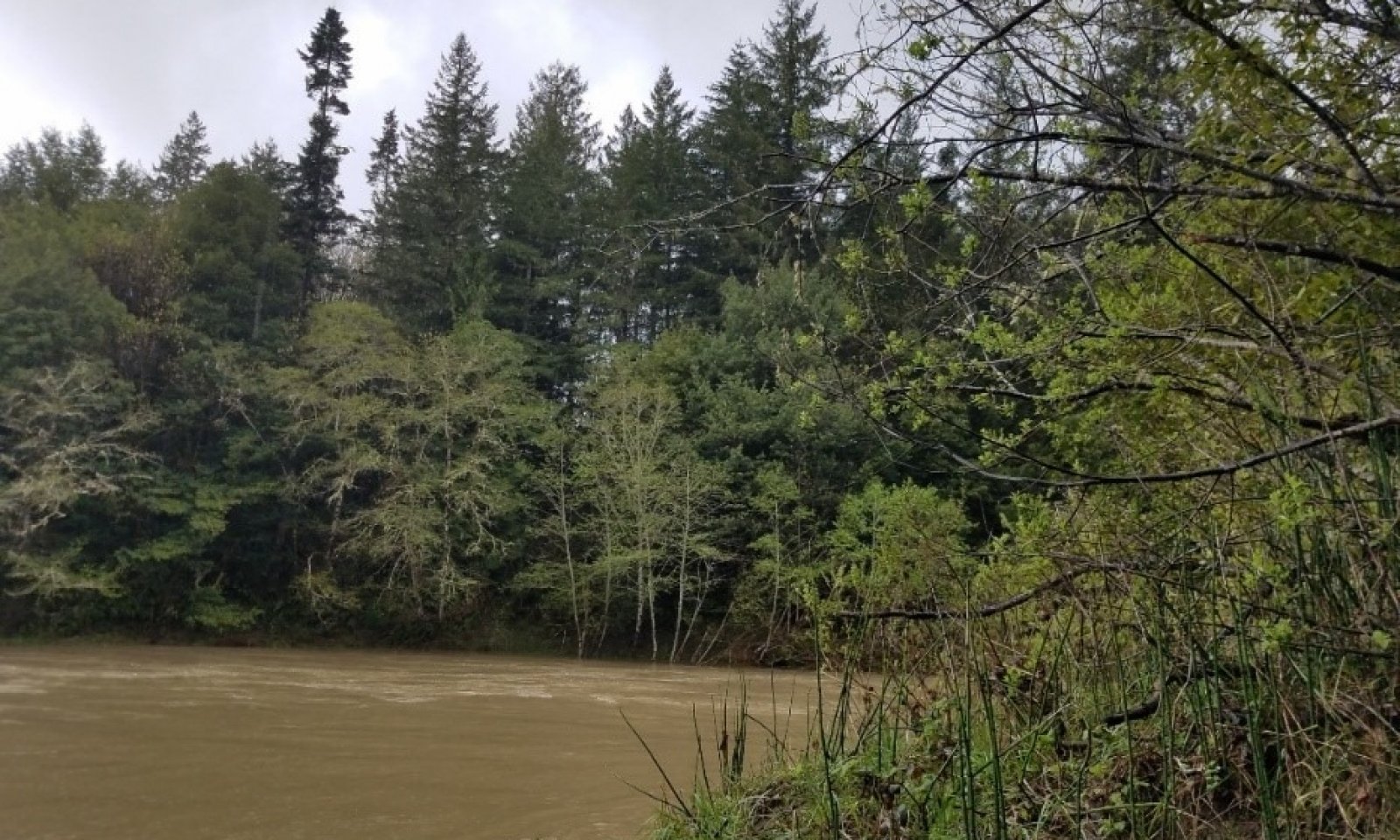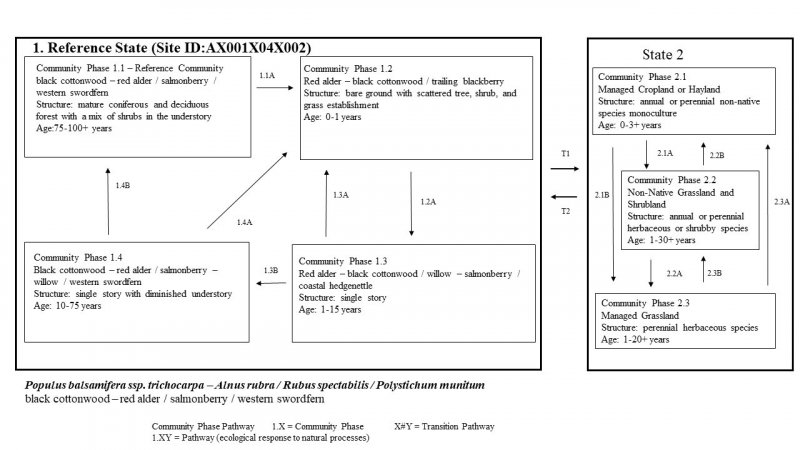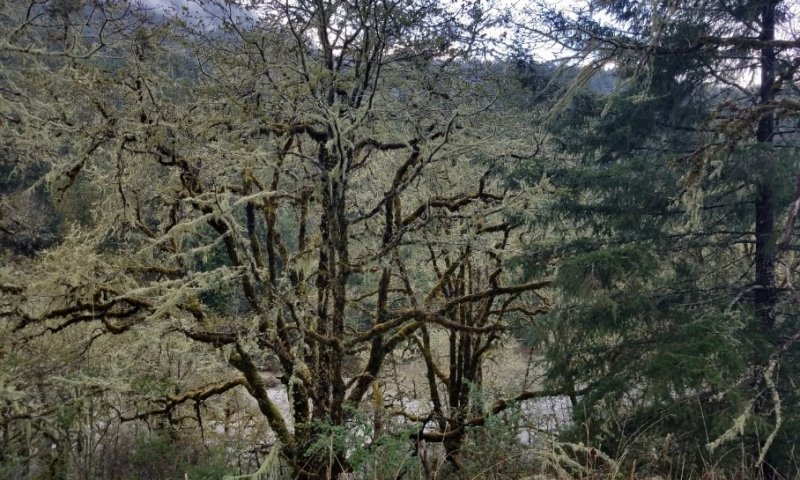Community 1.1
Black Cottonwood, Red Alder, Salmonberry, and Western Swordfern
Black cottonwood – red alder / salmonberry / western swordfern
Structure: mature coniferous and deciduous forest with a mix of shrubs in the understory
Black cottonwood is the most differentiating overstory species in the reference community and its dominance separates this site from Ecological Site Mesic Udic Riparian Forest (AX00103X002). Red alder and California laurel may dominate the canopy in some sites, especially where there are forest openings or pockets of disturbance. Regeneration is restricted by canopy cover and often limited to gaps where sunlight is most available. Additionally, conifers such as western hemlock (typically in stands older than 100 years) and Douglas-fir may also be present in the stand. Herbivory on western hemlock by elk (Cervus elaphus) and black-tailed deer (Odocoeleus hemionus columbianus) may greatly impact the prominence of these species (Stolnack, 2010).
The reference community represents a lack of major flooding for at least 75 years, allowing the pioneering species to form a mature canopy. The lack of flooding also allows the growth of a robust understory of shrubs including willows, salmonberry, red elderberry (Sambucus racemosa), thimbleberry (Rubus parviflorus), and snowberry (Symphoricarpos albus). Forbs such as western swordfern,, twistedstalk (Streptopus lanceolatus), and Oregon oxalis are also often prolific.
Common disturbances include small gap dynamics (1/2 acre openings or smaller) following the decline of the red alder canopy and minor scouring from flooding. Soil deposition following minor scouring from smaller scale and periodic flooding temporarily affects the understory community, but it does not alter the composition of the overstory. In addition, beaver (Castor canadensis) activity can by a significant driver in small scale disturbances, hydrologic morphology, and contribute to large woody debris in riparian edges and corridors.
Dominant plant species
-
black cottonwood (Populus balsamifera ssp. trichocarpa), tree
-
red alder (Alnus rubra), tree
-
Douglas-fir (Pseudotsuga menziesii), tree
-
western hemlock (Tsuga heterophylla), tree
-
bigleaf maple (Acer macrophyllum), tree
-
California laurel (Umbellularia californica), tree
-
salmonberry (Rubus spectabilis), shrub
-
thimbleberry (Rubus parviflorus), shrub
-
red elderberry (Sambucus racemosa), shrub
-
common snowberry (Symphoricarpos albus), shrub
-
willow (Salix), shrub
-
western swordfern (Polystichum munitum), other herbaceous
-
twistedstalk (Streptopus lanceolatus), other herbaceous
-
redwood-sorrel (Oxalis oregana), other herbaceous
Community 1.2
Red Alder, Black Cottonwood, and Trailing Blackberry
Red alder – black cottonwood / trailing blackberry
Structure: Bare ground with scattered tree, shrub, and grass establishment
Community phase 1.2 represents a riparian forest that is undergoing regeneration or stand initiation immediately following flooding disturbance. The soil surface is gravelly and highly variable depending on the intensity, frequency, and aggradation of the flooding event (Fonda, 1974). There may be scattered remnant mature trees in some areas and an abundance of woody debris. Successful regeneration is dependent on the local seed source, adequate seed bed, and sufficient light and water (Nierenberg, 2000). Red alder has several competition advantages and can establish quickly, relative to conifers. Red alder can sprout and establish in full sunlight and fixes nitrogen in poorly developed alluvial soils providing an early competitive advantage (Villarin, 2009). In addition, the deciduous species seeds are light and can be transported long distances by wind and water, allowing for rapid recolonization. Trailing blackberry (Rubus ursinus) is often established within this community phase.
Community 1.3
Black Cottonwood, Red Alder, Willow, Salmonberry, and Coastal Hedgenettle
Black cottonwood - red alder / willow – salmonberry / coastal hedgenettle
Structure: single story
Community phase 1.3 is an early seral forest in regeneration, possibly with scattered remnant mature trees. There is increased competition among individual trees for available water, light, and nutrients. Black cottonwood and red alder dominate the overstory in this phase. Trailing blackberry is a large component on the understory, however salmonberry and willow species begin to dominate the shrub layer. Coastal hedgenettle (Stacys chamissonis) and twistedstalk are often present in the forb layer.
Community 1.4
Black Cottonwood, Red Alder, Salmonberry, Willow, and Western Swordfern
Black cottonwood – red alder / salmonberry –willow / western swordfern
Structure: single story with diminished understory
Community phase 1.4 is a forest in the competitive exclusion stage, possibly with scattered remnant mature trees. Red alder tends to dominate the overstory, however red alder will begin to die between 40-70 years following disturbance and allow more light to penetrate the newly nitrogen rich soil (Naiman, 2009). As a result, conifer regeneration becomes more prevalent in this community phase.
Douglas-fir and western hemlock will begin to establish seedlings sporadically, especially in areas with higher shade, and at times within 4 years of hardwood establishment (Stolnack, 2010). Downed logs are an important component for conifer establishment which is more prevalent in more established stands (Villarian, 2009).
During this phase, canopy closure will mature to 100 percent, leading to diminished understory. If there is a presence of black cottonwood and red alder regeneration within this community phase, it may be inferred that frequent minor flooding has been influencing site dynamics (Nierenberg, 2000). Shade tolerant forbs such as western swordfern and Oregon oxalis establish during this phase. Over time, the forest begins to self-thin as a result of competition and a decrease in species that are not tolerant of shade.
Dominant plant species
-
black cottonwood (Populus balsamifera ssp. trichocarpa), tree
-
red alder (Alnus rubra), tree
-
Douglas-fir (Pseudotsuga menziesii), tree
-
western hemlock (Tsuga heterophylla), tree
-
California laurel (Umbellularia californica), tree
-
salmonberry (Rubus spectabilis), shrub
-
willow (Salix), shrub
-
California blackberry (Rubus ursinus), shrub
-
western swordfern (Polystichum munitum), other herbaceous
-
redwood-sorrel (Oxalis oregana), other herbaceous
Pathway 1.1A
Community 1.1 to 1.2
This pathway represents a stand replacing wildfire. catastrophic windstorm, or a major 100 or 500-year flood event which scours the stream channel, removes understory and overstory vegetation, and may alter the stream flow. This type of disturbance may completely reconfigure sediment loads and dramatically reduce or eliminate the forest overstory.
Pathway 1.2A
Community 1.2 to 1.3
This pathway represents growth over time with no further major disturbance.
Pathway 1.3A
Community 1.3 to 1.2
This pathway represents a stand replacing wildfire. catastrophic windstorm, or a major 100 or 500-year flood event which scours the stream channel, removes understory and overstory vegetation, and may alter the stream flow. This type of disturbance may completely reconfigure sediment loads and dramatically reduce or eliminate the forest overstory.
Pathway 1.3B
Community 1.3 to 1.4
This pathway represents growth over time with no further major disturbance.
Pathway 1.4B
Community 1.4 to 1.1
Black Cottonwood, Red Alder, Salmonberry, Willow, and Western Swordfern
Black Cottonwood, Red Alder, Salmonberry, and Western Swordfern
This pathway represents an area with no further major disturbance. Continued growth over time and ongoing mortality lead to increased vertical diversification. The community begins to resemble the structure of the reference community, with small pockets of regeneration (both deciduous and coniferous) and a more diversified understory.
Pathway 1.4A
Community 1.4 to 1.2
This pathway represents a stand replacing wildfire. catastrophic windstorm, or a major 100 or 500-year flood event which scours the stream channel, removes understory and overstory vegetation, and may alter the stream flow. This type of disturbance may completely reconfigure sediment loads and dramatically reduce or eliminate the forest overstory.
Community 2.1
Managed Cropland or Hayland
Managed Cropland or Hayland
Structure: Annual or perennial non-native species
Community Phase 2.1 may consist of a range of crops, including annually planted species, short-lived perennials, and more permanent shrubby crops. Hayland and grass-legume silage crops are also included in this community phase.
Community 2.2
Non-Native Grassland and Shrubland
Non-Native Grassland and Shrubland
Structure: Annual or perennial herbaceous or shrubby species
Community phase 2.2 is characterized by a low level of agronomic or management inputs such as added fertility, intensive grazing management, regular mowing or weed control. This plant community is often dominated by introduced weedy species. Sites with extremely low fertility or heavy grazing pressure will have a higher proportion of annual, stoloniferous or rhizomatous species. Wetland areas are often dominated by non-native rhizomatous grasses. This plant community can include remnants of commonly seeded introduced pasture species.
Community 2.3
Managed Grassland
Managed Grassland
Structure: perennial herbaceous species
Community phase 2.3 receives regular agronomic inputs, including adding soil nutrients and other soil amendments such as lime, implementing grazing management plans, regular mowing, controlling weeds, and reseeding as needed. This plant community typically includes introduced perennial pasture and hay species that commonly are seeded. In areas of historic native grassland, mixtures of perennial and annual native species may be seeded and managed by appropriate agronomic and livestock management activities. Minor amounts of introduced species that commonly are in non-native grassland and shrubland communities (community phase 2.2) are in this phase.
Pathway 2.1A
Community 2.1 to 2.2
In the absence of the following agronomic and livestock management activities, seeds from surrounding weedy plant communities will be transported to the site through factors such as wind, flood water, animals or vehicle traffic where adapted species will become established. Management activities could include tillage, addition of significant fertility or other soil amendments such as lime, mowing, burning, harvest or chemical control of vegetation, planting the site to desirable herbaceous species and implementation of grazing management plans.
Pathway 2.1B
Community 2.1 to 2.3
Agronomic and livestock management activities such as tillage, addition of significant fertility or other soil amendments such as lime, mowing, burning, harvest or chemical control of vegetation, planting the site to desirable herbaceous species and implementation of grazing management plans.
Pathway 2.2B
Community 2.2 to 2.1
Agronomic activities such as tillage, addition of significant fertility or other soil amendments such as lime, mowing, burning, harvest or chemical control of vegetation, and planting the site to desirable crop species.
Pathway 2.2A
Community 2.2 to 2.3
Agronomic and livestock management activities such as tillage, addition of significant fertility or other soil amendments such as lime, mowing, burning, harvest or chemical control of vegetation, planting the site to desirable herbaceous species and implementation of grazing management plans.
Pathway 2.3A
Community 2.3 to 2.1
Agronomic activities such as tillage, addition of significant fertility or other soil amendments such as lime, mowing, burning, harvest or chemical control of vegetation, and planting the site to desirable crop species.
Pathway 2.3B
Community 2.3 to 2.2
In the absence of the following agronomic and livestock management activities, seeds from surrounding weedy plant communities will be transported to the site through factors such as wind, flood water, animals or vehicle traffic where adapted species will become established. Management activities could include tillage, addition of significant fertility or other soil amendments such as lime, mowing, burning, harvest or chemical control of vegetation, planting the site to desirable herbaceous species and implementation of grazing management plans.
Transition T1A
State 1 to 2
This pathway represents a change in land use. Land management changes include modifications to the hydrologic function to develop pasture and agriculture. Non-native seed disbursement is introduced (intentionally or unintentionally) which alters the reference community.
Transition T2A
State 2 to 1
This pathway represents a transition to restore the natural hydrologic function and native plant habitat. Native seed sources are necessary to restore the community as well as extensive brush and invasive species management and mitigation.




